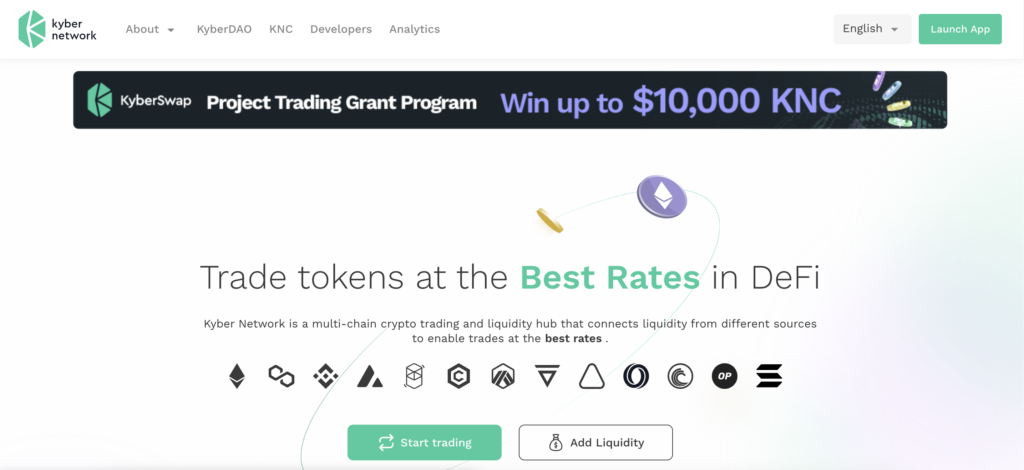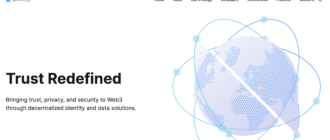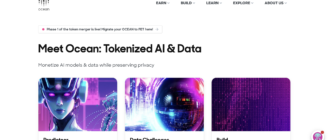In this article, we delve into the Kyber Network Crystal (KNC) project, a prominent player in the decentralized finance (DeFi) space. The Kyber Network aims to provide a comprehensive liquidity hub for decentralized applications (DApps), wallets, and other financial protocols. We will explore the intricacies of the project, including its technological framework, tokenomics, ecosystem, growth prospects, and future developments. This analysis will offer a detailed understanding of how Kyber Network Crystal operates and its potential impact on the DeFi landscape.

What is Kyber Network Crystal?
Kyber Network Crystal (KNC) is the native utility and governance token of the Kyber Network, a decentralized liquidity protocol designed to facilitate seamless and secure token swaps within the decentralized finance (DeFi) ecosystem. The Kyber Network serves as a multichain trading and liquidity hub that aggregates liquidity from various sources, such as token holders, market makers, and decentralized exchanges (DEXs), to provide users with the best possible trading rates. KNC holders can participate in governance through KyberDAO, enabling them to vote on crucial proposals and influence the network’s development and future trajectory. Additionally, KNC is used to pay for transaction fees within the Kyber ecosystem, unlock new features, and access community-driven rewards.
History of Kyber Network Crystal
Kyber Network was founded in 2017 and launched its initial coin offering (ICO) on September 15 of the same year, raising $52 million. The project was initially built on the Ethereum blockchain, utilizing the ERC-20 standard for its KNC token. Over the years, Kyber has achieved significant milestones, including the launch of its flagship product, KyberSwap, which is a decentralized exchange aggregator designed to provide the best trading rates by integrating liquidity from multiple sources. In April 2021, the Kyber team proposed and implemented an upgrade to the Kyber Network Crystal token, leading to the creation of Kyber Network Crystal (KNC). This upgrade aimed to enhance the token’s utility and governance capabilities.
Throughout its development, Kyber Network has expanded its support to multiple blockchain networks, including Ethereum, Avalanche, Polygon, BNB Smart Chain, Arbitrum, Fantom, Velas, and Cronos. The platform has also formed partnerships with various projects and integrated with major DeFi protocols like Uniswap v3. Despite encountering challenges, such as a significant security incident affecting its KyberSwap Elastic protocol, the network has continued to grow and innovate, securing its place as a key player in the DeFi space.
How Kyber Network Crystal Works
Underlying Technologies
Kyber Network Crystal (KNC) is built on the Ethereum blockchain and follows the ERC-20 token standard. The core functionality of Kyber Network revolves around its decentralized liquidity protocol, which aggregates liquidity from various sources, including token holders, market makers, and decentralized exchanges (DEXs). This aggregated liquidity allows Kyber to provide the best possible rates for token swaps across multiple blockchain networks.
The Kyber Network architecture includes two main protocols under its KyberSwap platform: KyberSwap Classic and KyberSwap Elastic. KyberSwap Classic employs a Dynamic Market Maker (DMM) protocol, which dynamically adjusts liquidity provider (LP) fees based on market conditions. This helps optimize returns for LPs and reduce slippage during volatile market conditions. Additionally, it features the Amplification (AMP) mechanism, enabling liquidity pools to simulate higher liquidity without requiring additional tokens, thereby improving capital efficiency.
KyberSwap Elastic, on the other hand, introduces a tick-based Automated Market Maker (AMM) with concentrated liquidity. This allows LPs to specify a price range for their liquidity, which can then be represented by an NFT. This mechanism not only increases the capital efficiency but also provides multiple fee tiers and Just In Time (JIT) protection to enhance security and earning strategies for LPs.
Blockchain and Consensus Mechanism
Kyber Network operates on the Ethereum blockchain, leveraging its security and smart contract capabilities. As an ERC-20 token, KNC benefits from Ethereum’s robust infrastructure, ensuring secure and transparent transactions. Kyber Network employs a Proof-of-Stake (PoS) consensus mechanism for its governance model. KNC holders can stake their tokens in KyberDAO to participate in governance decisions, such as protocol upgrades and fee adjustments. This staking process not only secures the network but also aligns the interests of KNC holders with the overall health and development of the ecosystem.
Distinguishing Features
Kyber Network distinguishes itself from other DeFi protocols through its comprehensive liquidity solutions and innovative mechanisms:
- Dynamic Fee Adjustment: Unlike traditional AMMs, KyberSwap Classic’s DMM protocol dynamically adjusts fees to reflect market volatility, optimizing liquidity provider returns.
- Amplification Mechanism: The AMP feature in KyberSwap Classic allows liquidity pools to mimic higher liquidity levels without needing additional tokens, thereby increasing capital efficiency.
- Concentrated Liquidity: KyberSwap Elastic enables LPs to concentrate their liquidity within specific price ranges, represented by NFTs. This not only enhances capital efficiency but also allows for better management of liquidity positions.
- Multi-Chain Support: Kyber Network supports multiple blockchain networks, including Ethereum, Polygon, BNB Smart Chain, Avalanche, and others, making it a versatile liquidity hub for the DeFi space.
- Governance via KyberDAO: The KyberDAO allows KNC holders to stake their tokens and vote on critical governance proposals, ensuring decentralized control and active community participation.
Technical Details
Kyber Network’s architecture ensures high security and efficiency. Smart contracts govern all operations on the network, from liquidity provision to token swaps. These contracts are audited by third-party firms to ensure their robustness and security.
The KyberSwap platform utilizes advanced algorithms for price discovery and trade execution. The Dynamic Trade Routing feature, for example, scans different DEXs to find the most suitable trading routes, optimizing each token swap for the best possible rates. Additionally, the Discover tool leverages on-chain data and AI to help traders identify trending tokens and make informed trading decisions.
Overall, Kyber Network Crystal combines advanced DeFi technologies with a robust governance model, offering a comprehensive solution for liquidity aggregation and decentralized trading.
Tokenomics of Kyber Network Crystal
Kyber Network Crystal (KNC) is a token, not a coin. This distinction is crucial as tokens are typically built on existing blockchains, whereas coins operate on their own native blockchains. KNC operates on the Ethereum blockchain, adhering to the ERC-20 token standard.
Token Allocation and Distribution
Kyber Network Crystal has a well-defined allocation and distribution model:
- Community Investors (Private + Public Sale): 61.06%
- Early Investors Sale: 1.00%
- Founders, Advisors, Team: 18.47%
- Company Operational Reserves: 19.47%
Supply Schedule
The initial supply of KNC was 226,000,000 tokens. After the ICO, the total supply was reduced to 215,625,348.84 KNC due to the burning of excess tokens. In April 2021, a token migration further adjusted the supply to 210,250,962 KNC. An additional 42,050,588 KNC was minted for the KyberDAO Ecosystem Growth Fund, resulting in a new maximum supply of 252,301,550 KNC.
Emission Model
KNC employs a dynamic emission model. The KyberDAO, the governance body of Kyber Network, has the authority to adjust the token supply to stimulate network growth, bootstrap liquidity, and reward early adopters. This dynamic approach ensures that the tokenomics can be adapted to meet the evolving needs of the network and its users.
Current Market Metrics
As of recent data, the circulating supply of KNC is approximately 188 million tokens, with a maximum supply capped at 252,301,550 KNC. The market price of KNC fluctuates based on market conditions, with recent trading prices around $0.60 to $0.80 per token.
Use Cases and Utility
KNC serves multiple purposes within the Kyber Network ecosystem:
- Governance: KNC holders can participate in governance by voting on proposals through the KyberDAO. This includes decisions on protocol upgrades, fee structures, and other critical changes.
- Liquidity Incentives: KNC is used to incentivize liquidity providers on KyberSwap. By staking KNC, liquidity providers can earn rewards from trading fees.
- Transaction Fees: KNC can be used to pay for transaction fees within the Kyber ecosystem, offering reduced fees for users who utilize the token for this purpose.
Price Trends and Forecast
The price of KNC has seen various fluctuations, influenced by market trends and the overall performance of the DeFi sector. Predictions for 2024 estimate the price range to be between $0.57 and $0.83, with potential growth driven by increased adoption and new integrations within the DeFi space.
Table: Key Metrics of KNC
| Metric | Value |
|---|---|
| Initial Total Supply | 226,000,000 KNC |
| Current Total Supply | 252,301,550 KNC |
| Circulating Supply | 188,092,455 KNC |
| Recent Trading Price | $0.60 – $0.80 |
| Allocation Breakdown | Community: 61.06%, Team: 18.47%, Company: 19.47%, Early Investors: 1.00% |
Kyber Network Crystal exemplifies a sophisticated approach to tokenomics, balancing supply dynamics with governance and utility functions to maintain a robust and adaptable DeFi ecosystem.
Where to Buy Kyber Network Crystal (KNC)
Kyber Network Crystal (KNC) can be purchased on several major cryptocurrency exchanges. Here are the top platforms where you can trade KNC:
- Binance: One of the largest and most popular cryptocurrency exchanges globally, offering a wide range of trading pairs for KNC, including KNC/USDT, KNC/BTC, and KNC/ETH.
- HTX (formerly Huobi): A major exchange offering diverse trading pairs and high liquidity for KNC. You can trade KNC against USDT and other major cryptocurrencies.
- MEXC: Known for its extensive list of altcoins, MEXC provides various trading pairs for KNC with good liquidity.
- Gate.io: A well-known platform for both spot and derivatives trading, Gate.io offers KNC trading pairs with competitive fees and deep liquidity.
- KuCoin: This exchange is popular among altcoin traders and provides numerous trading pairs for KNC, including KNC/USDT and KNC/BTC.
Where to Store Kyber Network Crystal (KNC)
Storing your KNC tokens securely is crucial. Here are the best wallet options for storing KNC:
- Ledger: A hardware wallet that provides high security for your private keys, keeping them offline and safe from hacks.
- Trezor: Another hardware wallet offering robust security features and support for KNC and other ERC-20 tokens.
- MetaMask: A popular Web3 wallet available as a browser extension and mobile app, allowing you to store and manage KNC easily.
- Coin98: A versatile wallet supporting multiple blockchains, including Ethereum, and offering features like staking and swapping.
- Trust Wallet: A mobile wallet that supports KNC and provides an easy-to-use interface for managing your tokens.
Whether you choose to store your KNC in a hardware wallet for maximum security or in a custodial wallet for ease of access to trading, ensuring the safety of your tokens is essential. Hardware wallets like Ledger and Trezor offer offline security, while MetaMask and Trust Wallet provide convenient options for frequent traders. For integrated trading and storage solutions, wallets associated with major exchanges like Binance, HTX, and KuCoin are excellent choices.
Project Growth Prospects
Basis for Growth
Kyber Network Crystal (KNC) has a solid foundation for growth based on its comprehensive and innovative liquidity solutions within the DeFi sector. The project has gained substantial traction due to its ability to aggregate liquidity from multiple sources, providing users with the best trading rates. This capability makes Kyber Network an integral part of the DeFi ecosystem, facilitating seamless token swaps and liquidity provision across various decentralized applications (DApps) and decentralized exchanges (DEXs).
The growth of Kyber Network is also fueled by continuous technological advancements and strategic partnerships. Recent integrations with major protocols like Uniswap v3 have expanded its reach and utility, making it more attractive to both liquidity providers and traders. Furthermore, Kyber’s support for multiple blockchain networks, including Ethereum, Polygon, BNB Smart Chain, Avalanche, and more, enhances its versatility and scalability in the DeFi landscape.
Clients and Partners
Kyber Network’s clients primarily include DApps, DeFi protocols, DEXs, and individual traders who require efficient and cost-effective liquidity solutions. Some notable partners and integrations include:
- Uniswap v3: Integrated into the KyberSwap ecosystem for enhanced liquidity and trading options.
- Bondex Professional Network: A partnership aimed at leveraging Kyber’s liquidity solutions.
- Pegaxy: An NFT racing game utilizing Kyber’s liquidity services.
Development Forecast
Kyber Network is expected to continue its upward trajectory by leveraging its technological innovations and strategic partnerships. The focus on expanding cross-chain capabilities and enhancing the KyberSwap platform will likely attract more users and liquidity providers, thereby increasing its market share in the DeFi sector. As the DeFi market grows, Kyber Network is well-positioned to capitalize on the increasing demand for efficient liquidity solutions.
Ecosystem
Kyber Network boasts a robust and diverse ecosystem designed to support various aspects of decentralized finance. The ecosystem includes:
- KyberSwap: The primary DEX aggregator that provides users with the best trading rates by aggregating liquidity from multiple sources.
- KyberDAO: The decentralized governance platform where KNC holders can stake their tokens and participate in decision-making processes, such as protocol upgrades and fee adjustments.
- Liquidity Providers: Participants who add liquidity to Kyber’s pools and earn fees and rewards. This includes individual traders and institutional players.
- DeFi Integrations: Kyber’s protocol is integrated with numerous DeFi applications and services, providing extensive liquidity and trading options across the ecosystem.
Ecosystem Participants
- KyberSwap Users: Traders who utilize the platform for efficient token swaps.
- Liquidity Providers: Individuals and institutions that provide liquidity to the pools.
- Governance Participants: KNC holders who stake their tokens in KyberDAO to influence protocol decisions.
- DApp Developers: Developers who integrate Kyber’s liquidity solutions into their decentralized applications.
Kyber Network’s extensive and interconnected ecosystem ensures that it remains a vital component of the DeFi landscape, supporting a wide range of financial activities and fostering continuous innovation and growth.
Conclusion
Kyber Network Crystal (KNC) represents a significant advancement in the DeFi sector, providing innovative solutions for liquidity aggregation and decentralized trading. The project’s continuous development and integration with multiple blockchain networks highlight its commitment to enhancing the user experience and fostering ecosystem growth. As Kyber Network continues to evolve, it stands poised to play a crucial role in the future of decentralized finance, offering robust and scalable solutions for the rapidly expanding crypto market.






